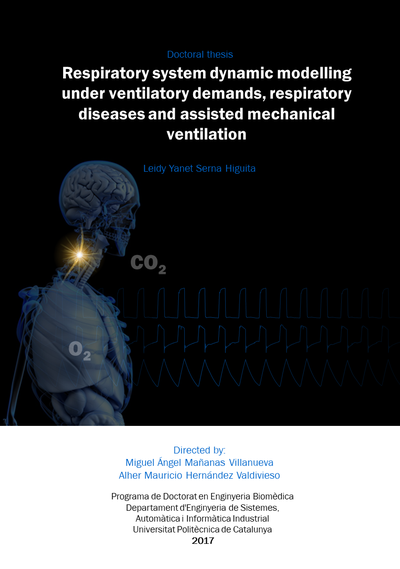L. Y. Serna, 2017
Modelado dinámico del sistema respiratorio ante incrementos de demanda ventilatoria, enfermedades pulmonares y ventilación mecánica asistida
By Leidy Yanet Serna
Directed by Miguel Angel Mañanas and Mauricio Hernández
04.09.2017
Summary
 Respiratory diseases remain one of the leading causes of death and illness in Europe and worldwide. One of the most important is Chronic Obstructive Pulmonary Disease (COPD) associated mainly with chronic bronchitis and pulmonary emphysema. Patients with COPD during acute respiratory failure (ARF) require mechanical ventilation to assist or replace their lung function, where the selection of ventilatory mode and its configuration is an essential step for patient's treatment and recovery.
Respiratory diseases remain one of the leading causes of death and illness in Europe and worldwide. One of the most important is Chronic Obstructive Pulmonary Disease (COPD) associated mainly with chronic bronchitis and pulmonary emphysema. Patients with COPD during acute respiratory failure (ARF) require mechanical ventilation to assist or replace their lung function, where the selection of ventilatory mode and its configuration is an essential step for patient's treatment and recovery.The development of pathophysiological knowledge and technology has generated a wide variety of ventilation modes designed to increase alveolar ventilation, reduce respiratory work, improve the coupling between ventilation and perfusion and optimize oxygenation of arterial blood. In clinical practice, however, many of the benefits they provide are often unused because of: 1) the complexity and diversity of ventilatory modalities and ventilator brands, and 2) the lack of tools to assist in the proper selection and configuration of the ventilatory modes according to the specific characteristics of each patient.
Several models of the respiratory system have been studied to enhance knowledge about the mechanism of ventilatory control that the system adopts in normal and pathological conditions and to predict its cardiorespiratory response. However, the connection between the respiratory control system and mechanical ventilators remains an open research field, since it is essential to know and predict properly the respiratory pattern and the parameters that affect it before to set up the ventilator.
The main objective of this doctoral thesis is the developed and evaluation of new computational simulators that allow predicting appropriately the respiratory dynamic response of healthy subjects and respiratory patients under ventilatory demands and assisted mechanical ventilation.
In this thesis, different models of the respiratory system are analyzed. Modifications in their modeling, adjustments in their parameters and comparative studies were performed in order to properly predict the response of the respiratory system in healthy and pathological subjects during increased ventilatory demand. In addition, a computational and interactive tool, based on a model that integrates the most relevant characteristics of the analyzed models and a model of a mechanical ventilator, has been developed to simulate the interaction between a respiratory patient and a mechanical ventilator.
The main contributions of the thesis are:
1) A new estimate of respiratory mechanical work with a better physiological meaning and whose minimization allows better prediction of the system control response.
2) A complete respiratory system model that properly predicts both transient and stationary response of a healthy subject under incremental ventilatory demands. This model uses an improved gas exchange and sensing respiratory plant and more appropriate optimization algorithms.
3) A complete model of the respiratory system that adequately predicts the response of obstructive and restrictive lung diseases. This model incorporates the simplification of a well-known, detailed and complete respiratory mechanical plant that is approximated quadratically for its computational integration in the model of the previous healthy subject. Mechanical parameters of three submodels for each disease are also proposed.
4) A computer simulator with a friendly and interactive user’s interface, which includes the previous analyzed models and a mechanical ventilator model. This tool, which has already been tested for usability, has been successfully used in courses for physicians, researchers and students
With all these tools, it is expected to provide resources that assist physicians in the configuration of mechanical ventilators and understanding the interaction patient-ventilator.
Share: